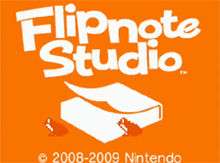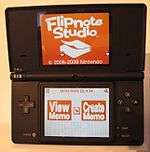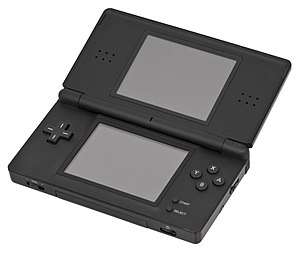Flipnote Studio
Flipnote Studio, originally released in Japan as Moving Notepad (うごくメモ帳, Ugoku Memochō), was a free downloadable application for the Nintendo DSi's DSiWare digital distribution service. Developed by Nintendo EAD Tokyo,[1] Flipnote Studio allowed the user to create both word and picture-based notes with the stylus, add sound, and put them together to create frame-by-frame flipbook-style animations. Though referred to as Moving Notepad by Nintendo in prior English-language keynote addresses and conferences,[2] the application was announced at E3 2009 officially as Flipnote Studio.[3] It was released in Japan on December 24, 2008, in North America on August 12, 2009, and in Europe and Australia on August 14, 2009. It was also included as a preloaded program on the Nintendo DSi LL/XL and Nintendo DSi with firmware 1.4. An online service, titled Flipnote Hatena (うごメモはてな, Ugomemo Hatena) allowed users to download flipnotes created by other users. Users were also able to post stills from flipnotes to the sharing site Miiverse.
| Flipnote Studio | |
|---|---|
 | |
| Developer(s) | Nintendo EAD Tokyo Group No.2 |
| Publisher(s) | Nintendo |
| Director(s) | Hideaki Shimizu |
| Producer(s) | Yoshiaki Koizumi |
| Platform(s) | Nintendo DSi, Nintendo 3DS (3D version) |
| Release | |
| Genre(s) | Memo/Notepad/Animation |
| Mode(s) | Single player, multiplayer online and locally |
Flipnote Studio is not available to be downloaded or transferred onto the Nintendo 3DS.[4] As a successor, Flipnote Studio 3D, was developed specifically for the system.
The online Flipnote Hatena (うごメモはてな Ugomemo Hatena) service officially retired on May 31, 2013. However, users were previously able to transfer the Flipnotes from their Flipnote Hatena account to the new online service provided with Flipnote Studio 3D, until the Flipnote Gallery World service was shut down on April 2, 2018.[5] After the Nintendo DSi Shop closed on March 31, 2017, the original Flipnote Studio was no longer available for download.
Features
Flipnote Studio offers the user three main tools with which to create drawings: a pen, an eraser, and a paintbrush (each heavily customizable) . With these tools, the user may create frames for short or long animated sketches, called Flipnotes. Additional features such as layering, shrinking, enlarging, moving, copying, cutting, pasting, etc. are also available, as well as the option to import black-and-white images via the DSi Camera Album (though not limited to black and white) . The Japanese version of the software allows the user to take photos directly from Flipnote Studio itself.[2][6] One animation may consist of hundreds of frames (maximum 999), and to go along with the animation itself, the user may choose to record up to 4 different sound banks (each holding up to 2 seconds of sound) with the DSi microphone OR importing from DSi Sound, then save it as a 'mastered' soundtrack (which can hold up to 1 minute of sound).[6] The speed ranges from 0.5 - 30 FPS.
When newly started, Flipnote Studio is set to right-hand mode. When drawing, the left and right buttons on the depad cycle through the pages. Pressing down will play the animation, and the up button will take the user to the tools section. The L button can trigger advanced tool options, such as enlarging the drawing instead of shrinking it. If the user uses left-hand mode - an option in the settings - the buttons will switch places, and mirror. Once activated, the R button will take place of the L button and so on.
Flipnote Hatena
Overview
Shortly before the release of Moving Notepad in Japan, Nintendo announced that they were partnering with Japanese web services provider Hatena to provide the means to share works created with the software. Speaking for Nintendo, Yoshiaki Koizumi stated they chose to work with Hatena because "it takes a special skill set to maintain the User Generated Contents (UGC) site, and we don't have that skill. We rely on Hatena on that part." [7]
_Screenshot.jpeg)
Flipnote Hatena is the name of both the portion of the Flipnote Studio application that connects to the Flipnote Hatena website as well as the website itself (the Japanese version of the program differentiates between the two, but not the English version). Through the DSi portion of the application users were able to download Flipnotes to their DSi, add stars to Flipnotes uploaded by others, and upload their own. Users could also 'spin off' another user's Flipnote, by downloading it and editing it. Flipnote Hatena was shut down on May 31, 2013.[6]
Description
As for the website itself, Flipnote Hatena offered the ability for users to rate and comment on the works of others, as well as to embed their animations into other webpages.[6] Users could also flag submissions as inappropriate; flipnotes thus flagged will not be viewable via the DSi's Flipnote Hatena[8] and may be removed from the website altogether.[9]
Channels
When uploaded, Flipnote animations were placed into specific categories by their creators. These categories, known as "channels," included general classifications such as "Musical" and "Comedy," as well as more specific categories suggested by popular Flipnote users and accepted by Hatena.[10] For example, one category entitled "Stick Figures" was suggested by the creator of a popular comedy Flipnote series known as TeenChat.[11] The series' animated cast, which consisted of floating faces and stick figures, established a basis in character design for comedy Flipnotes.[12] Another category that a user suggested to Hatena was a "Spoof" category, which included Flipnotes imitating songs, movies and other media. Users were able to place categories they visited or contributed to most often into their own "Most Visited" folder. The last Flipnote category to be added before the closing of Hatena in May 2013 was "Birds," a small category mainly consisting of a popular "Flipnote series" known as Birdie BAI.[13]
Stars
Flipnote Hatena also had its own economy of "stars." Stars were used to rate Flipnotes (similarly to YouTube's "like" function), and users could add as many stars as they desired to any Flipnote. In addition to the regular Stars, users could purchase or earn Color Stars. In increasing rarity, these colors were green, red, blue, and purple. Users could earn Green Stars by reporting inappropriate Flipnotes, using other Hatena services, posting Flipnotes frequently (based on the number of days they posted Flipnotes), or managing a popular Channel. Red Stars were given to creators whose Flipnotes were featured in the Weekly News. In addition, users could purchase "boxes" containing a certain number of color stars. The contents of these boxes were randomized, so users wouldn't know how many of each color they would receive, but the larger the box purchased, the more likely the user was to receive Color Stars.
The Star system on Flipnote Hatena had a mixed reception from users. The ability to add infinite stars was a major drawback, as a large part of the Flipnote Hatena community became focused on receiving as many stars as possible. This led to a practice referred to among the community as "star begging." These Flipnotes with no entertainment value, often direct copy of another, would quickly rise to the top of the Most Popular section.
End of the service
Prior to the release of Moving Notepad/Flipnote Studio 3D, the closure of the Flipnote Hatena communities was announced, and have been inaccessible as of May 31, 2013. Fans vocally protested the shutdown, and contacted Nintendo, Hatena, and even news media in an attempt to prevent the end of the services. Several fans even created websites and servers to continue sharing Flipnotes after the shut down.
Nintendo announced that the Flipnotes on Flipnote Hatena would be transferred to the new online service for Moving Notepad/Flipnote Studio 3D. The DSi Flipnotes were accessible from the Nintendo DSi Gallery, a free-to-access section of the upcoming Flipnote Gallery: World.[14] The main purpose of the DSi Gallery was for users to transfer their Flipnotes from Flipnote Studio to Flipnote Studio 3D, where they could be edited like any other Flipnote. Flipnote Gallery: World was never released outside of Japan. Instead, other regions were given a service called the Nintendo DSi Library, where users could download their Flipnotes from Flipnote Hatena. Services for Flipnote Gallery: World and Nintendo DSi Library were both ended on April 1, 2018.
Since the closure of the official servers, numerous groups have come forward to create unofficial servers to reimplement the application's online functionalities. The most notable of such custom servers is Sudomemo, which launched in 2014.[15][16]
Sharing Flipnotes
Aside from the Flipnote Hatena website, Flipnotes may be shared between two users via the DSi's Wireless Communication feature. When a Flipnote has been shared in this manner, the users may choose to save their contact information as friends on the Nintendo DSi and on the Flipnote Hatena website. Flipnotes may also be shared via saving to an SD card (to be inserted into another DSi).[6] When a person receives a Flipnote from a creator the first time, they become friends with each other.
Uses
Official contests
As part of the 25th Anniversary celebrations for the Mario (1985-2010) and Zelda (1986-2011) series, Nintendo has sponsored official Flipnote contests. For both contests, users were invited to create a Flipnote based on the series using template Flipnotes (with music and sound effects) posted on Flipnote Hatena. Entries were judged and selected by some of the head developers of the series, including Eiji Aonuma for the Zelda Flipnotes, and Shigeru Miyamoto for the Mario Flipnotes. Winning Flipnotes were made available to view on YouTube and Nintendo's official website, the Nintendo Channel, and the 3DS eShop (Zelda winners only).
Music Videos
Flipnote Studio has been used by musicians to create animated music videos for their songs.[17]
Billy Polard is one such artist. Polard used looping .gif files created in and exported from Flipnote Studio. For his song Losing Light, Polard's music video told a sad story about two monsters. A year later, Polard released a music video for another song, When Our Bedrooms Were Once Haunted, that was also created in Flipnote Studio.
Artist Arman Bohn took a different approach. For his music video for Brain Games, he created hundreds of elements, including anthropomorphic numbers and letters, in Flipnote Studio and exported them as .gifs. He then used computer software to assemble these elements into his music video. The random arrangement of objects was intended to serve as a contrast to the lyrics of the song, which is about the Scientific Method. In his blog, Arman Bohn described his effort to keep the "jaggy" quality of the Flipnote art.
A music video created partly in Flipnote Studio and animated by Kékéflipnote was used for The Living Tombstone's remix of Epoch by Savlonic
Development

Flipnote Studio was developed by Yoshiaki Koizumi and Hideaki Shimizu. The two began working on the project without the knowledge of anyone else at Nintendo EAD Tokyo.[18] It was initially designed as a tool for taking notes with the name Moving Notepad, and it was considered early on as a possible WiiWare application to transmit these notes from a DS to the Wii to be shared with other users of the application. When the Nintendo DSi was announced, it was decided by Nintendo president Satoru Iwata that the company would work with Hatena, as the latter had recently shifted its R&D department to Kyoto, where Nintendo Corporate Labs is located.[18]
It was released in Japan on December 24, 2008, in North America on August 12, 2009, and in Europe and Australia on August 14, 2009. It was also included as a preloaded program on the Nintendo DSi XL and Nintendo DSi with firmware 1.4.
Reception
| Reception | ||||||||||||||
|---|---|---|---|---|---|---|---|---|---|---|---|---|---|---|
| ||||||||||||||
| ||||||||||||||
As of January 10, 2009, there had been more than 100,000 user-submitted creations.[21] During its first six months of operation in Japan, Flipnote Hatena reports having received over 1,000,000 user-submitted creations.[9]
IGN gave the Flipnote Studio an "outstanding" rating of 9.0/10, while also giving it an editors' choice award.[20]
Official Nintendo Magazine awarded it 95%.
See also
References
- "Volume 7 - Flipnote Studio Creation". Nintendo.co.uk. December 2008. Archived from the original on 2012-06-30. Retrieved 2009-08-12. "I'm Yoshiaki Koizumi from Nintendo's EAD Tokyo Software Development Department. I was producer this time..."
- "Keynote Address by Satoru Iwata, President". Nintendo.co.jp. 2008-10-02. Retrieved 2009-01-10.
- "Nintendo :: E3 2009 :: Flipnote Studio". Nintendo.com. Archived from the original on June 11, 2009. Retrieved 2009-06-02. Cite journal requires
|journal=(help) - "Nintendo :: Official Website :: What DSiWare games can't be transferred to the Nintendo 3DS?". Nintendo.com. Retrieved 2011-07-14. Cite journal requires
|journal=(help) - "ニンテンドー3DSソフト『うごくメモ帳 3D』「ワールドうごメモギャラリー」サービス終了のお知らせ|サポート情報|Nintendo". Nintendo.co.jp. 2017-09-08. Retrieved 2018-05-10.
- "TIME TO GET ANIMATED WITH YOUR NINTENDO DSi! - Press Release". Spong.com. 2009-08-11. Retrieved 2009-08-11.
- Kaifu, Michi (2008-12-18). "Nintendo and Hatena come up with a cloudish service for DSi". Retrieved 2009-05-06.
- Tanaka, John (2008-12-18). "Nintendo Brings User Generated Content to DSi". IGN.com. Retrieved 2009-05-06.
- "News - Hatena launches European website for use with "Flipnote Studio" software for the Nintendo DSi". Hatena.com. 2009-08-11. Retrieved 2009-08-12.
- "Flipnote Hatena Contact". Hatena Co, Ltd. 2014-11-19. Retrieved 2014-11-19.
- "Stick Figures Channel - Flipnote Hatena". Hatena Co, Ltd. 2015-07-12. Retrieved 2015-07-12.
- "Flipnote Hatena TeenChat". Hatena Co, Ltd. 2011-08-24. Archived from the original on 2014-11-29. Retrieved 2014-11-19.
- ""Birdie BAI" - Birds Category". Hatena Co, Ltd. 2013-04-15. Retrieved 2014-12-31.
- http://flipnotestudio.nintendo.com/notice/
- https://www.sudomemo.net
- https://sea.ign.com/flipnote-studio-3ds/159306/news/the-april-fools-switch-joke-that-went-too-far
- Mitchell, Richard. "Sad, sweet music video made in Flipnote Studio". Joystiq. Retrieved 28 October 2013.
- Ishaan (August 12, 2009). "Flipnote Studio Started as a "Secret Project"". Siliconera. Retrieved 2009-11-29.
- "Flipnote Studio for DS Reviews". Metacritic. CBS Interactive. Retrieved 2019-05-14.
- Harris, Craig (2009-08-13). "Flipnote Studio Review". IGN. Ziff Davis. Retrieved 2019-05-14.
- "Flip Book Animation Software Proves Popular on the DSi". Nintendo World Report. 2009-01-10. Retrieved 2009-01-11.
